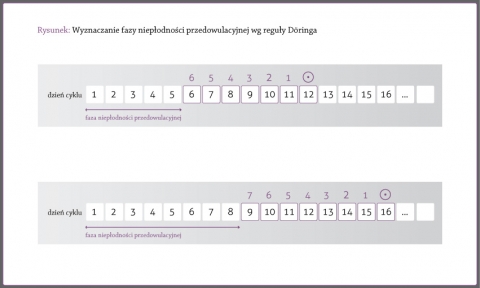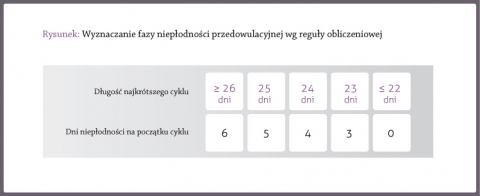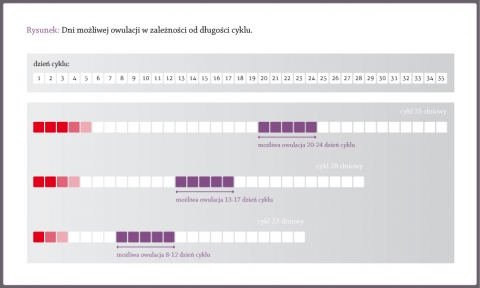
To interpret your cycle observation card properly which means to determine fertile and infertile days, you should take the following sequence of actions:
- No later than immediately after menstruation begin to carry out the self-observations, together with the measurement of basal body temperature (BBT).
- If you already have some experience in conducting self-observations (i.e. you have at least 12 Cycle Cards), you can determine the relative preovulatory infertile days using a modified Döring’s rule, Rötzer’s rule or calculation rule. If you have just started, you should not determine the preovulatory infertility but only the postovulatory one.
- Determine the day of mucus peak, that is the last day of stretchy, transparent or leaving wet - slippery sensation mucus.
- Select the first higher temperature after the peak of mucus symptoms – it must be higher than the 6 preceding lower temperatures (number them backwards - the highest of them will designate the baseline).
- Mark the following higher temperatures. If the third of them reached the higher temperatures level (it is 0.2 ˚ C above the baseline), that evening begins a period of the absolute postovulatory infertility. Otherwise, wait for the fourth temperature which should be above the baseline.
In the following sections the rules of determining infertile and fertile days will be discussed in details:
- The days of the preovulatory (relative) infertility can be determined by using of the Modified Döring’s Rule, which is based on statistical data from at least 12 observed cycles. It is based on the earliest date of temperature increase (Pearl Index <0.2).
- The preovulatory (relative) infertility lasts until the moment of noticing any of the following symptoms: “W” sensation, mucus observed during internal self-examination, changes of the cervix confirmed by self-examination (Pearl Index = 0.9)
- You can determine the preovulatory infertile phase only if the previous cycle was biphasic.
- For an inexperienced woman who has no observations or notes concerning the length of the last 12 cycles, the preovulatory infertile phase cannot be determined. However, if you have such data, you can use the Rötzer’s rule or calculation rule which are based on the length of your shortest menstrual cycle.
- Each of the rules can be applied only after ensuring that there are no current signs of fertility.
- The postovulatory (absolute, certain) infertility phase begins in the evening of the third day of the higher temperatures phase after observing the peak of mucus symptoms..
- The days which can be regarded as potentially fertile are those ones when any sign of cervical mucus can be noticed. Maximum fertility days are: the day of mucus peak and the following day; also the day when you can observe the minimum drop of temperature just before its rise to te level of higher temperatures and the first day of higher temperature.
The rules for determining the infertile days (conception postponing)
For couples postponing conception of a child the key factor is to identify periods of relative (preovulatory) and absolute (postovulatory) infertility. During the years of researches on female fertility some rules have been developed, which should be followed in order to determine these periods.
The rules of preovulatory infertility determination - infertile days
1. The dry day rule is based on observations of a current cycle. The appearance of any mucus is always a symptom of the fertility phase beginning, while the dry days are regarded as the days of natural infertility.
As far as the dry rule is concerned some significant assumptions must be made :
- the date of the appearance of “W” (careful observation) symptom - concerning the feeling of intense wetness and even bubbling in the vagina, together with the absence of mucus on the outside - begins a period of fertility and precedes the appearance of mucus in the near future;
- the very important issue of this rule is the inner observation (at the mouth of the cervix), since the presence of mucus can be seen there earlier than on the external genitalia. Internal observation should be carried out 1-2 times a day, external observation can be made during the every visit in the toilet;
- to avoid conception, the intercourse can be only taken in the evening, after the all-day observation.
- this rule does not apply in the case of cycles with the mucus phase shorter than 5 days.
2. The modified Döring’s rule uses the temperature chart for interpretation. This rule is based on the statistics of the 12-24 observed cycles. The seventh day before the date of the earliest observed temperature increase ( if the earliest higher temperature was on the 14th day of the cycle or later) or sixth day (if the earliest higher temperature occurred on the 13th day or earlier) is the last day of the relative infertility phase.
It was assumed that the women observing the continuous presence of less fertile mucus during the phase 1 can ignore this symptom within the limits of the Döring’s rule , but every change of mucus characteristics marks the start of the fertile period. Pearl Index for the Döring’s rule is less than 0.2.
In the first example the earliest higher temperature occurred on 12th day, which means that in this case preovulatory infertility falls from 1st to 5th day. In the second example, the earliest higher temperature occurred on 16th day of the cycle so the preovulatory infertility falls from 1st to 8th day of the cycle.
It should be noted that, as with other rules, the earlier appearance of any symptoms of fertility (the appearance of mucus, possibly changing the constant mucus or opening and softening of the cervix) begins a period of possible fertility.
3. The calculation rule is based on the survey results of doctors and researchers dealing with the methods of NFP (Natural Family Planning), concerning the shortest cycles. These researches confirmed the relative infertility in the first six days of the menstrual cycle when a woman’s cycles are 26-day or longer. Depending on the statistical length of the 24 previous cycles the preovulatory infertility chart is as follows:
It should be noted that if according to the Döring’s rule there are less days of preovulatory infertility, that result should be taken into account . If any of mucus or cervix symptoms were observed earlier, it should be regarded as the beginning of the fertile period.
4. The Rötzer’s first 6 days rule assumes that a woman can regard the first 6 days of the cycle as a period of relative infertility if her cycles last at least 26-days and she hasn’t observed any signs of fertility. Pearl Index for this rule is less than 0.2.
5. The cervix rule can be used when you decide to self-examination of the cervix. According to this method of preovulatory infertility phase lasts until the last day of the hard and closed cervix. Any change in the direction of opening, softening, or the appearance of mucus is a sign of fertility beginning. It should be noted that the Pearl index for this rule is 0.9, which means lower efficiency of this method compared to the Rötzer’s or Döring’s rule.
Note! Do not determine the days of infertility at the beginning of the cycle, if in the previous cycle phase you haven’t observed the higher temperatures phase, (the cycle was monophasic).
The rules of postovulatory (absolute, certain) infertility determination - infertile days
1. The basic rule of professor Joseph Rötzer was created on the basis of surveys carried out by him and his institute and it marks the beginning of the period of the absolute infertility in the evening of the third day of higher temperatures phase, if:
- all three higher temperatures are after the day of mucus peak ,
- last of the three higher temperatures is at or above the line of higher temperatures, i.e. at least about 0.2 ˚ C above the baseline, defined by the six lower temperatures,.
- If the third temperature does not reach the level of higher temperatures, you should wait for the fourth temperature which does not have to be at a higher temperatures level, but it should be above the baseline.
Note: It is important to mark the three higher temperatures as certain ones (with a circle) only after the day of mucus peak. If the chart of temperature begins to rise before the peak, such measurements should be treated as an early rise of temperature and marked with ↑.
2. The temperature rule - has been developed for women having difficulties with noticing any symptoms of mucus (symptom “S” is not noticeable at all), but observing the two phases on the basal body temperature chart. In the case of this rule the absolute phase of infertility begins in the fourth evening of temperature rise above the baseline providing that the three last measurements of temperature should be at least at higher temperatures level.
3. The Billing’s method claims that from the beginning of the fourth day after the peak of mucus symptoms to the menstrual bleeding there is a period of infertility, unless of course any mucus symptoms are noticed.
The rules for determining the fertile period (pregnancy planning) - fertile days
Observing any cervical mucus always means entering a period of fertility, but the day of ovulation is difficult to determine it precisely. There are four indicators helping with the determination of the ovulation moment:
- The appearance of the most fertile mucus - stretchy, transparent or leaving wet - slippery sensation.
- The first day of lowering the quality of mucus – which means the appearance of less fertile one directly after day of mucus peak.
- The one-day drop in temperature just before its rise on the level of higher temperatures, which occurs close to the moment of ovulation, if it is preceded by several days with the more fertile mucus.
- The first day of temperature rise. The first higher morning temperature may be observed a few hours after ovulation, so this is the time of the highest fertility.
It would be wrong to assume that the days of fertility for all women are about 14th day of the cycle or half cycle. Ovulation usually occurs between 12th and 16th day before the next menstruation. The figure below presents the possible ovulation days depending on the length of the menstrual cycle.
Note 1. It should be remembered that the ability of sperm to survive in good cervical mucus may be up to sixth days, while the egg retains its ability to fertilize up to 12 hours (24 hours for the release of two eggs).
Note 2. The cycle can be considered as fertile if it is biphasic, i.e. after the lower temperatures phase there is the higher temperatures phase.
Note 3. The higher temperatures phase lasting at least 10 days indicates a fertile cycle. According to researches confirmed by several experts in the field of fertility (e.g. Ober and Döring), shortening the phase of higher temperatures to less than 10 days is a sign of infertility.




